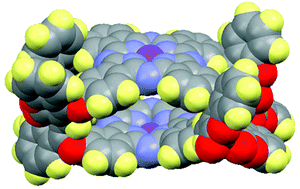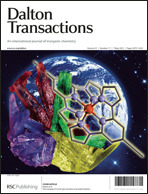Photovoltaic and electrocatalytic properties of novel ball-type phthalocyanines bridged with four dicumarol†
Abstract
The new ball-type metallo bisphthalocyanines (Co2Pc2 and Zn2Pc2) were synthesized from the corresponding [4,4′-bis(dicoumaroylphthalonitrile)] which can be obtained from the reaction of 3,3′-methylenebis(4-hydroxy-2H-chromen-2-one) and 4-nitrophthalonitrile. The structures of the newly synthesized compounds have been confirmed and characterized by elemental analysis, UV/Vis, IR and 1H NMR spectroscopies and MALDI-TOF mass spectrometry. Solar cells of the configuration ITO/Co2Pc2/C60/Al and ITO/Zn2Pc2/C60/Al were fabricated. The effect of the thickness of the active Pc layer – the thickness of the Pc layer was varied from 15 to 80 nm – on solar cells parameters has been investigated. A nearly thickness independent open circuit voltage was observed in both structures. The maximum photovoltaic conversion efficiency, short circuit current and fill factor were observed in ITO/Zn2Pc2/C60/Al cell with 80 nm Pc layer to be 0.255%, 1 mA cm−2 and 0.38, respectively. The redox properties of the ball-type complexes were investigated by cyclic voltammetry, controlled-potential coulometry and in situ spectroelectrochemistry in DMSO–TBAP. The electrochemical measurements showed that the complexes form ring-based and/or metal-based mixed-valence species, due to the remarkable intramolecular interactions between the two metal phthalocyanine units. The Vulcan XC-72(VC)/Nafion(Nf)/Co2Pc2 modified glassy carbon electrode showed much higher catalytic performance towards oxygen reduction, compared to the VC/Nf/Zn2Pc2 modified one. It was found that the VC/Nf/Co2Pc2 catalyst is nearly insensitive to the presence of methanol. In the presence of 1 M methanol in the electrolyte, the catalytic performance of the Co2Pc2-based catalyst in oxygen reduction was much better than that of the Pt-based one. Thus, it was shown that the VC/Nf/Co2Pc2 catalyst can be a good alternative to VC/Nf/Pt as a cathode catalyst in direct methanol fuel cells.


 Please wait while we load your content...
Please wait while we load your content...